
Photographic Guide to Top Three Holy Lakes in Tibet
Taking photographs is like a default part of any travel. Be a tourist or a traveller, photography is one of the popular ways to document your experiences. Tibet is in no short for soul cleansing experiences and mind blowing views. Photography trips to the three holy lakes of Tibet- Namtso, Yamdrok, and Manasarovar are popular among the travellers.
Camera Gears and Tips:
Basic equipment: DSLR, lenses, bag/ kit, camera strap, tripod & ball head, hoodman loupe, lens filters, reflector kit, remote shutter release, camera and lens cleaning equipment, lens hood, protective weather gear.
• When it comes to high altitude photography, it is preferable to carry wide angle camera and lenses.
• Keep enough memory cards at hand.
• Extra fully charged batteries as batteries seem to drain out soon in low temperatures.
• A UV lens should be used to protect from the UV rays.
• It is better to take small tripod and photoflash lamp for a steadier and better photography.
• Try to keep your gear as light as possible, as most of the places require trekking and a lot of walking.
• Ask permission before taking pictures of the locals and the shrines.
• It might be a little hard to find points to recharge your battery.
Namsto Lake:
Situated at an elevation of 4,750m, it is located 250km from Lhasa along the Qinghai- Tibet highway. It is 70km long and 30km broad. It is the second largest and highest salt water lake in China. Namtso, when translated, means the heavenly lake. True to its name, the sight of the lake and its surroundings are truly heavenly.
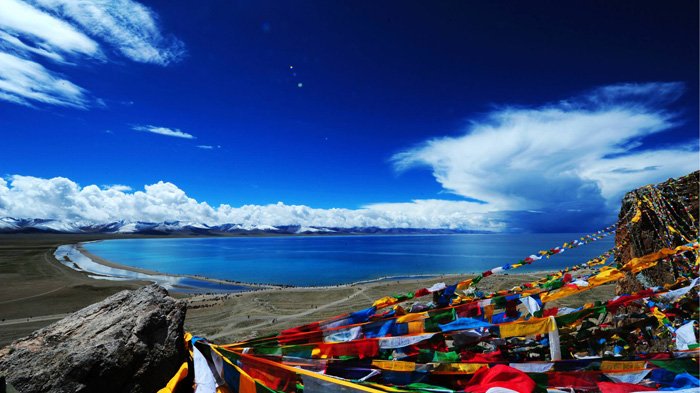 Namsto Lake
Namsto Lake
Join-in Lhasa and Lake Namtso Small Group Tour
How to get there:
Once you arrive at Lhasa, stay there for a couple of days to acclimatize. As the lake is in a much higher altitude than Lhasa, you might experience altitude sickness. There is no regular bus as such to Namtso Lake from Lhasa. It is best to charter a bus or car with other tourists. You can book private cars. They cost about CNY 1700 one way. If you are travelling by the Qinghai- Tibet highway, it is 60km northwest of Damxung. From Damxung you can arrive at Namtso Lake by car, bicycle, trek or even horse riding.
Best time to visit and what to photograph:
The best time to visit is probably from May to September, the summer and autumn months. Mind you, during colder months the road is not accessible and tourists can’t get to Namtso Lake.
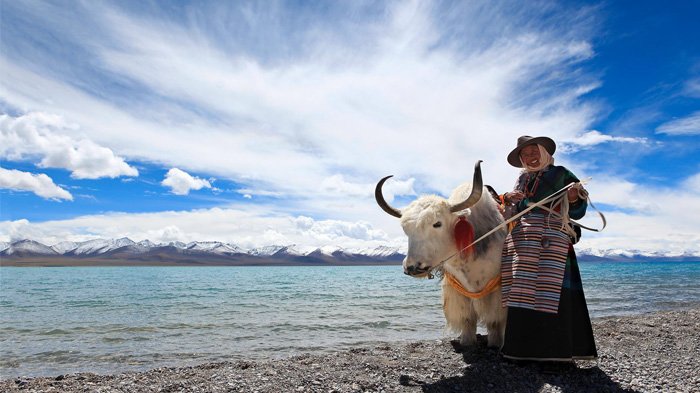 Namsto Lake
Namsto Lake
The best time to photograph is 30mins before or after sunrise and sunset. You can shoot Tashi peninsula’s south bay and the snow-capped silver mountains of Nyainqentanglha ranges with a golden glow at sunrise and Tashi peninsula’s north lakeshore at sunset.
Along the way you can photograph the Nyainqentanglha ranges, Yangpachen hot springs, and Nagenla pass. You can climb up the Tashi peninsula for more spectacular views of the Namtso Lake. You can also visit the nearby bird sanctuary to click some migratory birds.
 Namsto Lake
Namsto Lake
Yingbin stone, Gassho stone, Good and evil hole, Tashi peninsula re the areas you can use as foreground for shooting.
Accommodation and food:
Tourists can stay overnight near the lake by camping in tents. There are also tent guesthouses, each bed costs about CNY30. Power cuts are quiet frequent. Namtso Tent house, on the banks of Namtso Lake has 3 to 4 beds in each room. There are also some guesthouses around the lake, they warmer to stay compared to tents. Most tourists head back to Lhasa for the night, but the staying by the lake has its own perks. Tourists can also stay on top of the Tashi peninsula in tents.
A lot of tent eateries come up during peak seasons in the Tashi peninsula. The food prices are higher compared to Lhasa and Damxung. You will mostly find Sichuan cuisine in this place.
Yamdrok Lake:
Standing at an elevation of 4, 441m, Yamdrok Lake is situated 110km southwest of Lhasa. Yamdrok is an ancient name meaning upper pasture. The lake is 130km long and 70km broad. This lake has very low salinity and is fed by water melted from ice. Apart from photography, bird watching and cycling are some of the popular activities around the lake. This lake is the largest inland lake in the northern ranges of Himalayas. The lake is famous for its turquoise blue colour water surface.
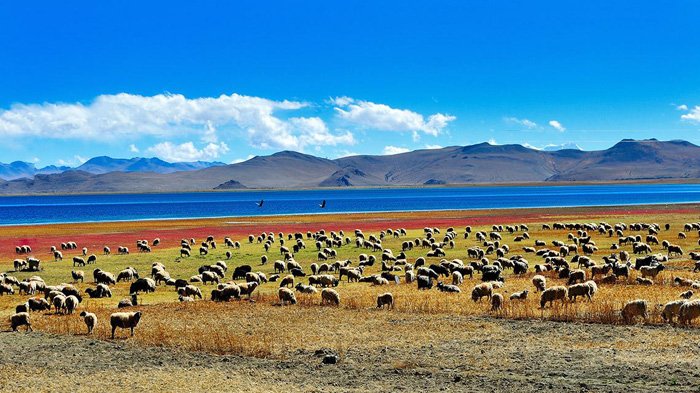 Yamdrok Lake
Yamdrok Lake
Join-in Lhasa and Yamdrok Tso Lake Tour
How to get there:
From Lhasa it takes about 2- 3hrs to reach this lake. Once you pay the entrance fee, you can enter, walk along the banks of the lake or even hike a little bit in one of the surrounding mountains. If you want to take the pictures of dogs or Yaks it is not free. They cost about CNY 10. The best way to drive over would be to go over Kambala pass. The view of the lake from the pass will be as beautiful as seeing the lake up close. Driving along the mountains adds more beauty to the whole experience.
Best time to visit and what to photograph:
The best time to visit is July to September, the autumn and spring months. During the summer it rains a little bit leaving the skies gray and sober looking. So, it is not really an ideal set up to get a good photograph. From November, the lakes start freezing as the winter begins.
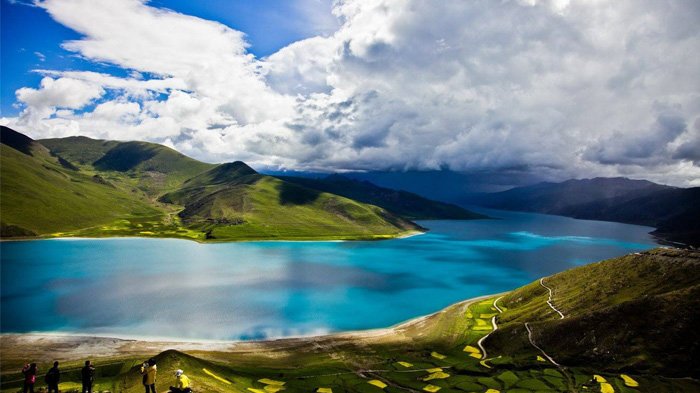 Yamdrok Lake
Yamdrok Lake
The best time to photograph is 30mins before and after sunrise and sunset. The mild orange glow of the sun over the lake from the Kambala pass is surely a magnificent sight to be captured. The surrounding mountain ranges are also a worthy picturesque view to be captured.
Along the way, when you stop at the Kambala pass observatory you can lake the coral shaped unevenness of the lake and the snow-capped ranges in the side. A little further, the turning of the road is also a good place to photograph.
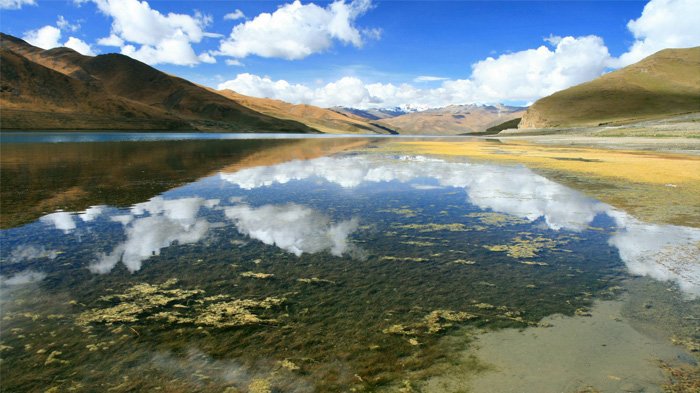 Yamdrok Lake
Yamdrok Lake
Once you reach the lake, surrounding it are a lot of small islands which are a habitat for migratory birds. With a little bit of luck you can capture the birds in motion. Other animals like yaks, Tibetan mastiffs, and goats can also be captured but not for free. The locals charge a nominal fee of CNY10. The adventurous souls can trek around the lake by foot to capture more angels of the majestic scenery that is the lake and the mountains. You will come across many prostrating Tibetans, as they consider walking around the lake thrice in clockwise direction. Do not capture the pictures of locals without their permission. They consider it rude and some find it to be inauspicious to be photographed.
Nearby attractions you can shoot are karola glacier and Palcho Monastery in Gyantse County.
Accommodation and food:
There are not many restaurants or eateries in the lake area. You can find small eateries on both sides of the highways. You can mostly find only Sichuan cuisine food. The price of the food is same as that of Lhasa.
There are no hotels to stay near Yamdrok Lake . You can either camp near the lake or go to Langkazi County. That is where you will find the nearest hotel to stay. Langkazi is about 10km from the south of Yamdrok. You can find basic guest houses and restaurants.
Manasarovar Lake:
At an altitude of 4, 588m it is the highest freshwater lake in the whole world. The name Manasarovar, when translated, literally means ‘the invincible/ immortal lake of jade.’ It is considered as the most sacred of all lakes to the Tibetans. This lake is the source for four important rivers in Asia namely the Indus, the Brahmaputra, the Sutlej and the Karnali. It is around 80km in circumference. It is not just grandeur views of lake, Mt. Kailash and spiritual fulfilment that the lake is known for. There are also a lot of mysteries surrounding the lake. Chat up with some locals and they will tell you all about it.
 Manasarovar Lake
Manasarovar Lake
Join-in Kailash Manasarovar Adventure Tour
How to get there:
From Lhasa Manasarovar lake is about 938km. Tourists usually go on a 7- day or 10- day trip and cover a lot of places and sightseeing in between and en route. A popular route is usually as follows: Lhasa-- Gyantse County--Shigate-- Everest Base Camp-- Saga-- Manasarovar. From Guge the lake is about 40km. this is only possible if you are a part of any organised tour by an agency. It is too much of a risk to go by yourself or hitchhiking without knowing the language. This trip is one of the most frequented by travellers in Asia. Don’t be surprised to find people performing rituals and taking a dip in the lake even in sub-zero conditions.
Best time to visit and what to photograph:
The best time to visit is from late April to late October. During these months the sky is bright, the water is clear and the reflections of the clouds are simply marvellous. During the winter months it becomes really cold and is inaccessible sometimes.
 Manasarovar Lake
Manasarovar Lake
Apart from taking the pictures of the lakes from the shore and with the majestic mountains as a background, there are 5 monasteries in the banks of lakes around it. Chiu is the most popular monastery in the northwest shore of the lake. The four other monasteries following Chiu in the clockwise direction are Gossul, Trugo, Yerngo, and Seralung. The south of the lake you find the Himalayas.
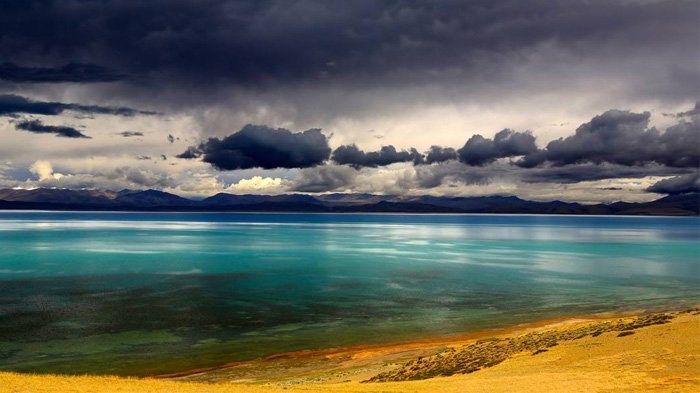 Manasarovar Lake
Manasarovar Lake
You will find a lot of Tibetans walking around the lake, which is about 82km. There is a small dirt lake surrounding the lake where you can go around lake even by car. It takes about 3 hours to drive. This is a good way to capture more photos from many different spots. You will even find Yak skulls in the pilgrim route around the lake.
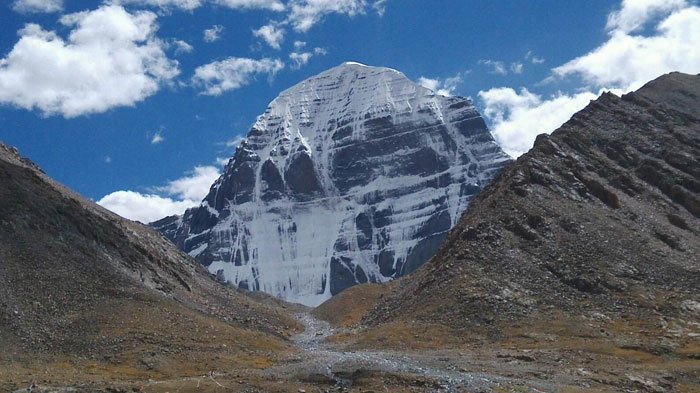 Holy Mt.Kailash
Holy Mt.Kailash
Many tourists go to Kailash from Manasarovar, it’s a 3 day trek. The trek is definitely worth the views you will be seeing.
Accommodation and food:
You can camp in the lake shore for the night. Most of the tourists choose to camp in lake for the night to capture the sunrise in the morning. There are also basic guesthouses around the lake.
There are small restaurants and hotels too, so the finding food will not be an issue. But if you go sometime between November and January (in the succeeding year) most of the guesthouses and restaurants will be closed for the harsh winters.
For anyone wishing to do photography in Tibet, Tibet Vista can help to sort out your permits and documents, and arrange all the details of the tour, and are also able to customize it to meet your exact requirements.

The Lhasa-born prodigy used to study business overseas, and got his Bachelor of Business in Nepal and India before moving back to his homeland. With pure passion for life and unlimited love for Tibet, Kunga started his guide career as early as 1997.
Responsible, considerate, and humorous, he devoted his entire life to guiding and serving international tourists traveling in Tibet. As a legendary Tibetan travel guru with 20-year pro guide experience. Currently, he is working in Tibet Vista as the Tour Operating Director. Whenever our clients run into trouble, he is your first call and will offer prompt support.


.jpg)



0 Comment ON "Photographic Guide to Top Three Holy Lakes in Tibet"